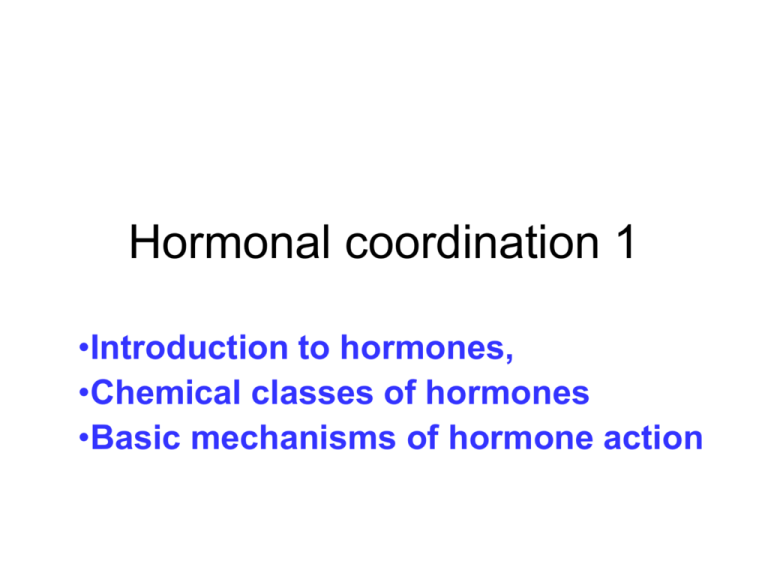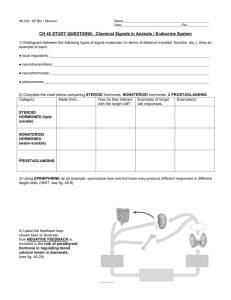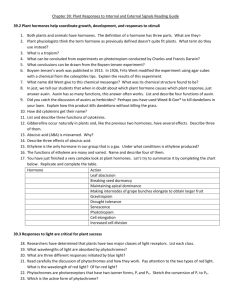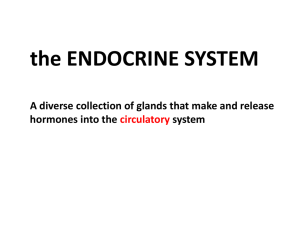hormones 1
advertisement

Hormonal coordination 1 •Introduction to hormones, •Chemical classes of hormones •Basic mechanisms of hormone action At the end of the lecture you will be able to • explain how hormones can identify the target cells. • compare mechanism of action of a lipid soluble hormone with that of a water soluble hormone. Regulation of homeostasis by endocrine system • Hormones delivered to tissues throughout the body by blood • All body cells affected • Resulting action –changes in metabolism • Slow response, action longer Endocrine glands release hormones to blood target tissue (target cell) Effects (change in structure and/or function) Why only some cells respond to a particular hormone? • Although a hormone travels throughout the body in the blood, it affects only specific cells (target cells) • Hormones influence the target cells by binding to specific proteins (receptors) in the target cell • Only target cells for a certain hormone have receptors that bind & recognize the particular hormone Main classes of hormones 1. Steroids 2. Amines 3. Peptides & proteins 4. Eicosanoids 1. Steroids : aldosterone, testosteron, estrogen, progesterone, cortisol etc. 2. Amines : adrenaline, noradrenaline, thyroxine, T3 3. Peptides & proteins: all hypothalamic releasing and inhibiting hormones, oxytocin, ADH, insulin, glucagon, parathyroid hormone etc. 4. Eicosanoids ;e.g. prostaglandins, leucotrienes (produced by all cells except RBCs) Hormone transport in blood • Soluble in plasma Peptide & protein hormones, adrenaline, noradrenaline • Bind with transport proteins in the blood Thyroxine, T3, steroid hormoness hormone action • Response to a hormone depends on hormone & target cell • Various target cells respond differently to the same hormone e.g insulin stimulates synthesis of – glycogen in liver cells – Triglycerides in adipose cells Response to a hormone may be • Synthesis of new molecules • Change in permeability of plasma membrane • Alter rate of metabolic reactions • Cause contraction of smooth & cardiac muscles etc. • Only the target cells for a certain hormone have receptors that bind and recognize that hormone, (TSH binds on receptors of the cells of thyroid gland, not on ovarian cells) • Lipid soluble hormones –receptors inside the target cell • Water soluble hormones – receptors on the plasma membrane of the target cell Lipid soluble hormones – mechanism of action 1. Hormone diffuse from blood through interstitial fluid & enter into cells through plasma membrane 2. If the cell is the target cell, the hormone binds to receptors in the cytosol cytosol 3. Activated receptor alter gene expression : it turns specific genes of nuclear DNA on or off 4. DNA is transcribed, new mRNA forms, leaves the nucleus & enter cytosol 5. New mRNA direct the synthesis of new proteins on ribosomes 6. New proteins alter cell’s activity & cause typical physiological response of that hormone Water soluble hormones – mechanism of action They cannot diffuse through phospholipid bilayer of the plasma membrane to attach the receptor inside the cells. Receptor for water soluble hormones present on the plasma membrane of the target cell G protein 1. Hormone diffuses from blood through interstitial fluid, & binds to receptors on the plasma membrane of the target cell 2. This binding activates another membrane protein (G protein) which acts to turn on adenyl cyclase 3. Adenyl cyclase converts ATP to cAMP in the cytosol of the cell 4. cAMP (second messenger) activates one or several protein kinases (an enzyme that phosphorylate cell proteins) 5. Activated protein kinases phosphorylate enzymes (Activate or inactivate some enzymes) 6. This could regulate other enzymes, secretion, protein synthesis, & changes in membrane permeability. • After a short period, phophodiesterase enzyme inactivate cAMP, the cell’s response is turned off until new hormone molecule binds to the receptor. • Several other substances also serve as second messenger Summary • Hormones, receptors, target cells • Four chemical classes of hormones • Mechanism of action of a lipid soluble hormone • Mechanism of action of a water soluble hormone









